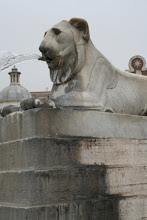
Today's been another scorcher - around 30 degrees, patchy clouds/sun and very little breeze. Rome is sweltering. The gelaterie are doing a roaring trade, as are the fruit vendors and the mobile food stands - not only in mineral water, but also brightly coloured parasols and straw fedoras. The modern-day gladiators are wearing shorts under their armour, and they're sweating profusely. There's hardly a blade of grass on the parks surrounding the Forum, and as we head up the Campidoglio, Michelangelo's beautiful square on the Capitoline Hill, we can look down on the Forum and see a few figures plodding among the ruins. It looks much more appealing up above the Forum, on the Palatine Hill, where Rome's great senators built their houses and where Rome's founders, Romulus and Remus supposedly camped. It cool and green up there and surprisingly empty.
Today, though, we are heading to San Clemente, the three-level church that is behind and a little uphill from the Colosseum on the Via Labicana. On the way down the Via dei Fori Imperiali, the street that runs from the Forum to the Colosseum, there are several living "statues", motionless in the blazing heat. I see a gold-wrapped Tutenkhamen - he was there last year when I walked the same road. We get beckoned by a statue painted in white greasepaint, wearing a white robe and strings of pearls. He shakes hands very theatrically with us, and we're still holding hands with him as we take photographs.
Although much of ancient Rome is buried under the layers of the modern city, there are still sites with access to the temples, houses, tombs and public buildings of the early Romans. One of these is San Clemente. In the1850's the Irish Dominican monks began to excavate the foundations of their church, expecting to find some remains of an early building underneath. They found two structures - the early 4th century church, still following the exact outline of the church above, and below this 4th C building, earlier pagan and Roman domestic building of the first century. So, 60 feet below modern Rome, you can contemplate a Roman courtyard, giving on to a series of rooms with herringbone brick floors, domed ceilings and central openings to let in the air and light. A corridor runs along the outer wall of the courtyard, and next to this is the pagan temple of Mithras. A smallish room with stone benches contains a central carved altar, with a relief of the god Mithras wresting the bull, his foot crushing the serpent below. At this level, the Roman springwater from a subterranean stream rushes on by, louder in places where grills expose the water foaming on below.
Although much of ancient Rome is buried under the layers of the modern city, there are still sites with access to the temples, houses, tombs and public buildings of the early Romans. One of these is San Clemente. In the1850's the Irish Dominican monks began to excavate the foundations of their church, expecting to find some remains of an early building underneath. They found two structures - the early 4th century church, still following the exact outline of the church above, and below this 4th C building, earlier pagan and Roman domestic building of the first century. So, 60 feet below modern Rome, you can contemplate a Roman courtyard, giving on to a series of rooms with herringbone brick floors, domed ceilings and central openings to let in the air and light. A corridor runs along the outer wall of the courtyard, and next to this is the pagan temple of Mithras. A smallish room with stone benches contains a central carved altar, with a relief of the god Mithras wresting the bull, his foot crushing the serpent below. At this level, the Roman springwater from a subterranean stream rushes on by, louder in places where grills expose the water foaming on below.
Back on ground level again, we head back along the V. Fori Imperali to the Piazza Venezia, today humming with crowds and parading soldiers - something big is happening. As we head down the Via Vittorio Emanuel, we see TV cameras and even more police holding up the pedestrian traffic around the Berlusconi residence. Looks like a visiting dignitary might be about to arrive, but the evening news might tell us more. For now, we head back for a late lunch in the Navona district - and ideal time to be lingering over a salad and wine while the commercial sites close down for the siesta.

Hi Liz and Jim; all sounds wonderful so far. Dad is avidly following your travels and asked me to give you his love - he has had trouble signing in to comment. Hope the weather continues fine and your time relaxing. Chris X
ReplyDelete